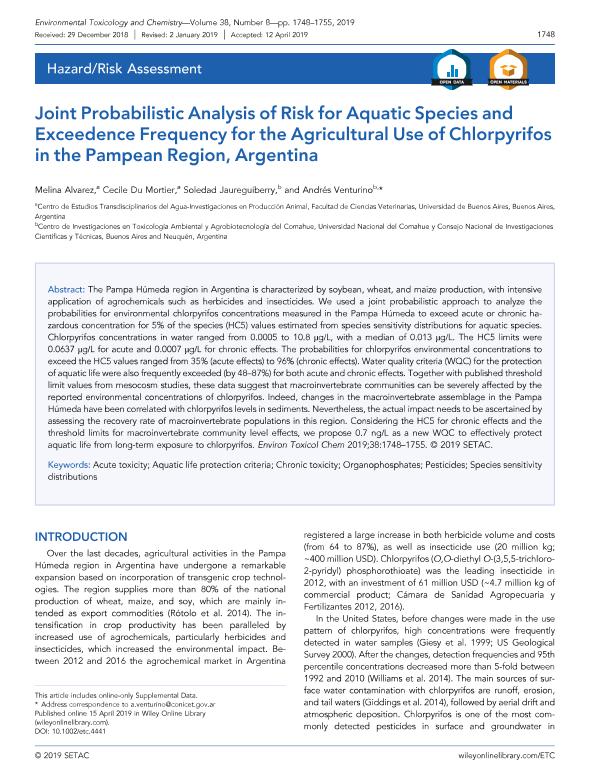Mostrar el registro sencillo del ítem
dc.contributor.author
Alvarez, Melina Andrea

dc.contributor.author
Du Mortier Podesta, Cecile Marie

dc.contributor.author
Jaureguiberry, María Soledad

dc.contributor.author
Venturino, Andres

dc.date.available
2021-09-07T16:22:54Z
dc.date.issued
2019-04-15
dc.identifier.citation
Alvarez, Melina Andrea; Du Mortier Podesta, Cecile Marie; Jaureguiberry, María Soledad; Venturino, Andres; Joint Probabilistic Analysis of Risk for Aquatic Species and Exceedence Frequency for the Agricultural Use of Chlorpyrifos in the Pampean Region, Argentina; Society of Environmental Toxicology and Chemistry; Environmental Toxicology and Chemistry; 38; 8; 15-4-2019; 1748-1755
dc.identifier.issn
0730-7268
dc.identifier.uri
http://hdl.handle.net/11336/139822
dc.description.abstract
The Pampa Húmeda region in Argentina is characterized by soybean, wheat, andmaize production, with intensive application of agrochemicals such as herbicides and insecticides. We used a joint probabilistic approach to analyze the probabilities for environmental chlorpyrifos concentrations measured in the Pampa Húmeda to exceed acute or chronic Hazard Concentration-5 (HC5) values estimated from Species Sensitivity Distributions (SSD) for aquatic species. Chlorpyrifos concentrations in water ranged from 0.0005 to 10.8 µg/L with a median of 0.013 µg/L. The HC5 limits were 0.0637 µg/L for acute and 0.0007 µg/L for chronic effects. The probabilities for chlorpyrifos environmental concentrations to exceed the HC5 values ranged from 35% (acute effects) to 96% (chronic effects). Water Quality Criteria (WQC) for the protection of aquatic life were also frequently exceeded (48%-87%) for both acute and chronic effects. Together with published threshold limit values from mesocosm studies, these data suggest that macroinvertebrate communities can be severely affected by the reported environmental concentrations of chlorpyrifos. Indeed, changesin the macroinvertebrate assemblage in the Pampa Húmeda have been correlated with chlorpyrifos levels in sediments. Nevertheless, the actual impact needs to be ascertained by assessing the recovery rate of macroinvertebrate populations in this region. Considering the HC5 for chronic effects and the threshold limits for macroinvertebrate community level effects, we propose 0.7 ng/L as a new WQC to effectively protect aquatic life from long-term exposure to chlorpyrifos.
dc.format
application/pdf
dc.language.iso
eng
dc.publisher
Society of Environmental Toxicology and Chemistry

dc.rights
info:eu-repo/semantics/openAccess
dc.rights.uri
https://creativecommons.org/licenses/by-nc-sa/2.5/ar/
dc.subject
ACUTE TOXICITY
dc.subject
AQUATIC LIFE PROTECTION CRITERIA
dc.subject
CHRONIC TOXICITY
dc.subject
ORGANOPHOSPHATES
dc.subject
PESTICIDES
dc.subject
SPECIES SENSITIVITY DISTRIBUTIONS
dc.subject.classification
Otros Tópicos Biológicos

dc.subject.classification
Ciencias Biológicas

dc.subject.classification
CIENCIAS NATURALES Y EXACTAS

dc.title
Joint Probabilistic Analysis of Risk for Aquatic Species and Exceedence Frequency for the Agricultural Use of Chlorpyrifos in the Pampean Region, Argentina
dc.type
info:eu-repo/semantics/article
dc.type
info:ar-repo/semantics/artículo
dc.type
info:eu-repo/semantics/publishedVersion
dc.date.updated
2021-01-08T14:16:48Z
dc.journal.volume
38
dc.journal.number
8
dc.journal.pagination
1748-1755
dc.journal.pais
Estados Unidos

dc.description.fil
Fil: Alvarez, Melina Andrea. Universidad de Buenos Aires. Facultad de Ciencias Veterinarias. Centro de Estudios Transdisciplinarios del Agua; Argentina. Consejo Nacional de Investigaciones Científicas y Técnicas; Argentina
dc.description.fil
Fil: Du Mortier Podesta, Cecile Marie. Universidad de Buenos Aires. Facultad de Ciencias Veterinarias. Centro de Estudios Transdisciplinarios del Agua; Argentina
dc.description.fil
Fil: Jaureguiberry, María Soledad. Consejo Nacional de Investigaciones Científicas y Técnicas. Centro Científico Tecnológico Conicet - Patagonia Confluencia. Centro de Investigaciones en Toxicología Ambiental y Agrobiotecnología del Comahue. Instituto de Biotecnología Agropecuaria del Comahue | Universidad Nacional del Comahue. Facultad de Ciencias Agrarias. Centro de Investigaciones en Toxicología Ambiental y Agrobiotecnología del Comahue. Instituto de Biotecnología Agropecuaria del Comahue; Argentina
dc.description.fil
Fil: Venturino, Andres. Consejo Nacional de Investigaciones Científicas y Técnicas. Centro Científico Tecnológico Conicet - Patagonia Confluencia. Centro de Investigaciones en Toxicología Ambiental y Agrobiotecnología del Comahue. Instituto de Biotecnología Agropecuaria del Comahue | Universidad Nacional del Comahue. Facultad de Ciencias Agrarias. Centro de Investigaciones en Toxicología Ambiental y Agrobiotecnología del Comahue. Instituto de Biotecnología Agropecuaria del Comahue; Argentina
dc.journal.title
Environmental Toxicology and Chemistry

dc.relation.alternativeid
info:eu-repo/semantics/altIdentifier/url/https://onlinelibrary.wiley.com/doi/abs/10.1002/etc.4441
dc.relation.alternativeid
info:eu-repo/semantics/altIdentifier/doi/http://dx.doi.org/10.1002/etc.4441
Archivos asociados
